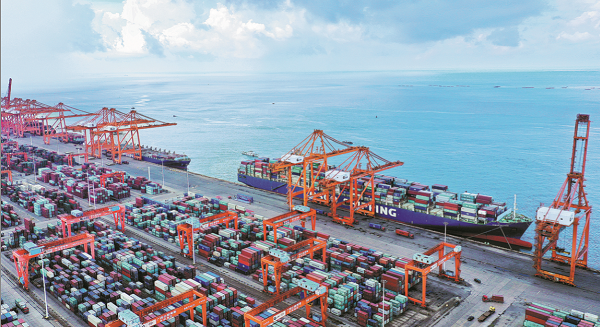RCEP will spur development across China, region and world

China COSCO Shipping's Zhongyuantaicang container ship, with a tonnage exceeding 10,000 tons, docks at the Beibu Gulf Port in Qinzhou, Guangxi Zhuang autonomous region. [Photo provided to China Daily]
The Regional Comprehensive Economic Partnership agreement is the 19th free trade agreement, or FTA, signed between China and other partners. The country to date has reached FTAs with 26 countries and regions, further improving the global FTA network, and forming a regional development strategy with a large-size free trade area.
The opening-up layout of such an FTA network is conducive to promoting China's new dual-circulation development pattern. The new pattern is centered on the domestic economy and aims at better integrating the domestic economy with the global economy. It will not only benefit the Chinese economy but also create more growth opportunities for countries across the world.
To mitigate the impact of the COVID-19 pandemic and other uncertainties on the regional economy, China must seize this rare opportunity, actively promote the implementation of the RCEP, share the development dividends of the FTA, rely on the regional market and the various connectivity facilities to reach mutually beneficial or win-win cooperation.
Promoting regional economic and trade cooperation on the RCEP platform will open up new space for China's economic growth and add new impetus to regional and even global economic recovery and development.
China has close economic ties with other RCEP member countries. The RCEP's 15 member countries account for about 30 percent of the world's total population, economy and trade, and are the world's largest free trade zone, or FTZ, with the largest population.
With the pandemic leading to a general decline in the world economy, the East Asian economic circle has shown great resilience and growth potential. As the most populous and manufacturing business-based region in the world, backed by relatively complete supply and industrial chains, the East Asian economic circle has frequent and dense exchanges of goods, people and capital among its members.
The circle has generally established an economic cycle from financing, scientific and technological research and development, raw material supply, production and processing to consumption.
The other member countries of the RCEP are also China's important trading partners. China's total trade with other RCEP member countries exceeded $1.43 trillion in 2019, accounting for 31.2 percent of its total foreign trade.
Despite the impact of the pandemic, China's total trade with other RCEP member countries amounted to $664.4 billion in the first half of this year, accounting for about one-third of China's total foreign trade. Meantime, China attracted $7.2 billion in foreign direct investment from other RCEP member countries, accounting for 10 percent of its total use of foreign capital.
In addition to the Association of Southeast Asian Nations' vital role in bilateral trade with China and the future development of the RCEP, the signing of the RCEP will help remove the obstacles in the ongoing negotiations of the China-Japan-Republic of Korea FTA.
The implementation of the RCEP has great significance and marks a breakthrough in regional economic integration, mainly in three important ways.
First, the pact will promote regional trade and investment liberalization to a new level. The RCEP will achieve a high level of openness within the region. With regard to trade in goods, member countries will further open their markets to each other.
As they have pledged that tariffs on most products would be reduced to zero immediately or within a decade, this FTA would achieve substantial and phased opening-up results in a relatively short period of time.
In the area of trade in services, the overall level of openness of the 15 member countries is significantly higher than the previous FTAs.


